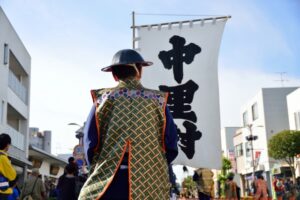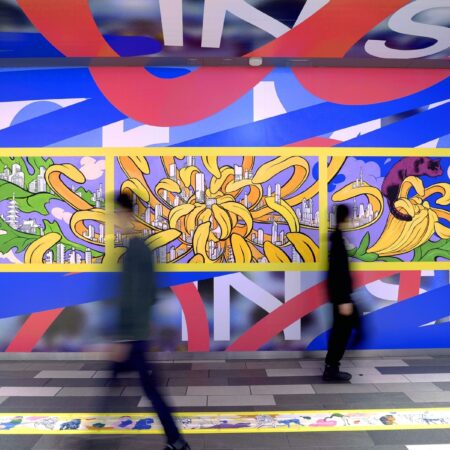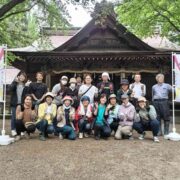大名行列って何?どこで開催される? What is the Daimyo procession? Where are they held?

着物を着たり見たりして、昔の日本を思い起こさせるような体験がしたいというのは、多くの人にとって観光の楽しみではないでしょうか。
そんな願いをかなえてくれるのが「大名行列」。まるで400年前の日本にタイムスリップしたかのようなイベントです。今回は日本語と英語で紹介します。
Contents
日本の五街道を歩く大名行列 Daimyo procession, walking on the “Five Roads” in Japan
大名行列は、侍が家臣を従えて領地と幕府を往来していたことが起源です。
国の権力者である将軍から領地を与えられていたので、自分の領地を守る一方で将軍に仕える必要があったからです。
12世紀ごろから始まった風習ですが、江戸時代の1635年に徳川3代将軍が出した命令により正式な制度となって日本に定着しました。
地方の広大な領地を治める「大名」という身分の侍は、将軍への服従を示すため、1年ごとに領地と江戸(東京)を行き来しなければならず、地方にとっての一大行事でした。
The daimyo procession originated as a journey by samurai with their subordinates between their territory and the central government.
The samurai were given territories by Shogun, the ruler of the country. They had to serve the shoguns while protecting their own territories.
Beginning around the 12th century, the tradition was officialized in 1635 during the Edo period, when the third Tokugawa Shogun issued an order.
Daimyo-ranked samurai with vast territories had to travel between provinces and Edo (Tokyo) every year to show their loyalty to the Shogun, which was a big deal for each region.
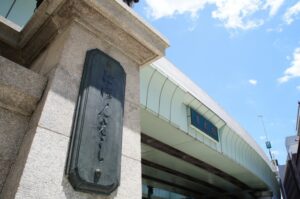
大名の往来に使われていたのが、今も残る五街道というルートです。
- 東海道:江戸(東京)の日本橋から京都の三条大橋までを結ぶルートです。
- 中山道:日本橋から三条大橋までを内陸経由で結ぶ別ルートです。
- 甲州街道:日本橋から甲府(山梨県)を経て長野の下諏訪へつながるルートです。
- 奥州街道:日本橋から青森県の津軽半島にある三厩までつづく、日本一長い街道です。
- 日光街道:日本橋から栃木県の宇都宮を経て日光に至るルートです。
現在では、東海道の箱根(神奈川県)をはじめ、五街道沿いの多くの地域で大名行列を再現するお祭りが行われています。
The “Five Roads” used by Daimyos still remain today.
- Tokaido: A route connecting Nihonbashi in Edo (Tokyo) to Sanjo Ohashi in Kyoto.
- Nakasendo: Another route connecting Nihonbashi to Sanjo Ohashi via inland.
- Koshu Kaido: This route connects Nihonbashi to Shimosuwa in Nagano via Kofu (Yamanashi Prefecture).
- Oshu Kaido: The longest road in Japan, leading from Nihonbashi to Minmaya on the Tsugaru Peninsula in Aomori Prefecture.
- Nikko Kaido: This route runs from Nihonbashi to Nikko via Utsunomiya in Tochigi Prefecture.
At present, festivals to recreate the Daimyo procession are held in many areas along the 5 roads, Hakone (Kanagawa Prefecture) on Tokaido, for example.
大名行列の登場人物 The characters in Daimyo procession
現在の大名行列のイベントは、江戸時代に地方から江戸に向かった大行列を再現し、数十名から100名規模の市民が伝統的な着物や道具で仮装をして練り歩くものです。
その豪華絢爛さは今でも目を見張るほどですが、当時は武家同士の見栄の張り合いで、行列に加わる従者の人数を競ってますます豪華になっていったそうです。
どんな役割の人が歩いているか、注目してみましょう。
Today’s Daimyo procession events are a reenactment of the grand processions from back during the Edo period, where Daimyo had to travel from their territories to Edo. The Daimyo procession events would have dozens to a hundred citizens parading in costumes with traditional kimonos and props.
The splendor of the procession is spectacular, even today. Back in the day, Samurai lineages were used to show off wealth to expand, and showing flamboyance is common during processions.
Let’s take a look at what roles there were during a procession.
行列の先頭を行く人たち People at the front of the procession
露払い Tsuyu harai
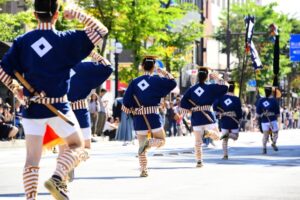
先頭に立って、行列の始まりを大きな声で知らせる人です。
最もよく知られているかけ声は「下にー、下にー」というもの。「土下座しろ」と命じるものです。
ほかには、道を空けさせる「片寄れー」というかけ声もよく使われていました。
先頭には化粧傘を持つ人が立って指揮をとります。
現在のイベントでは、化粧傘の使い手は保存会のボランティアが務め、伝統継承のために練習に励んでいます。
The people that lead the way and loudly announce the beginning of the procession.
The most well-known call is “Shita ni, shita ni,” meaning “get down on your knees.”
Another common command is “Katayore” which means “to give the way.”
At the front of the line, a person holding a decorated umbrella conducts the event.
Today, a volunteer from the preservation society serves as a conductor and practices to carry on the tradition.
箱持ち Hako mochi

黒塗りの木製で家紋が描かれた携行箱の運搬人です。箱の上部に棒を通して肩に担ぎます。
中には大名や家臣たちの衣類や文書が入っています。
運搬人は武士ではなく、農民などの庶民が雇われていました。
この箱は、飛脚と呼ばれる郵便配達人もよく使っていました。
宅配会社のシンボルとして、今でもよく描かれるアイテムです。
The carrier of a black, lacquered wooden box with an imprinted crest. The box is carried on the shoulder, with a pole attached to the top of the box.
Inside the box are the clothes and documents of the Daimyo and their subordinates.
Carriers were not warriors, but farmers and other migrants.
These boxes were also often used by mail carriers called Hikyaku.
The item is still often depicted as a symbol of the courier company.
槍持ち Yari mochi

行列の前方を歩き、槍のパフォーマンスで大名の威厳を表現していました。
槍は儀式用のものでカラフルな毛が付いています。
現在のイベントでは、槍を持って踊るバトンパフォーマンスのような舞が見られます。
They walked at the front of the procession, expressing the dignity of the Daimyo with their spear performance.
The spears are ceremonial and have colorful fur.
The current event features a spear dance, similar to a baton performance.
弓隊 Yumi tai
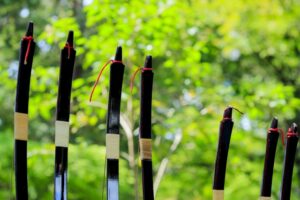
弓を運ぶ前衛部隊です。16世紀以降は鉄砲がありましたが、弓矢もまだ戦闘に使われていました。
いくつかの弓を束ねてかごに入れて運ぶ人と、矢を木箱に入れて運ぶ人がチームになって動いています。
The vanguard unit carrying the bows. After the 16th century guns existed, but bows and arrows were still used in battle.
They bundled several bows and carried them in baskets. The arrows were carried together in a wooden box working as a group.
鉄砲隊 Teppo tai

大名行列にとって、鉄砲は重要な武器です。
鉄砲は赤い毛織物に入れられ大切に運ばれていました。
現在のイベントでは、発砲訓練を受けた人たちが演武を行っています。
もちろん空砲ですが、爆音と演技の迫力は抜群です。
For the daimyo procession, guns were important weapons.
They were carefully carried in red, woolen cloth.
Today’s events are performed by the people trained to fire shots.
Of course, they are blanks, but the sound of the explosions and the power of the performance are outstanding.
徒士 Kachi

大名の警護を務める武士です。大勢の武士たちが、整然と隊列を組んで行進します。
身分の高い武士は兜をかぶっていますが、この人達はかぶっていません。
下級ではあったものの、刀を持つことが許されるれっきとした武士でした。
現在のイベントでは、この役目の人全員が「ちょんまげ」という昔の髪型のかつら、着物、模造刀を着けることができるので大変人気です。
These warriors guard the Daimyo. A large number of warriors march in an orderly formation.
High-ranking warriors wore Kabuto helmets, but these men did not.
Although they were of a lower rank, they were legitimate warriors who were allowed to carry Katana swords.
For today’s events this role is very popular, because they are allowed to wear old-fashioned wigs called Chonmage, kimonos, and imitation swords.
行列の後方を行く人たち People at the back of the procession
お殿様 Otonosama
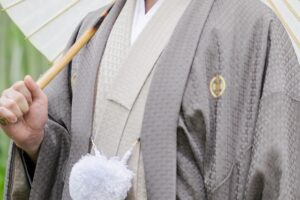
お殿様は大名の敬称で、行列の主役となる人です。
大名は道中ずっと、駕籠という小さな家のような乗り物に乗り、家臣が数人がかりで担いでいました。
現在のイベントでは、市長など地元のリーダーがお殿様を務めます。
駕籠も再現され、大名行列保存会の人々が担いでいます。
Otonosama is an honorary title for the Daimyo, the leading role in the procession.
Daimyo would ride in a Kago, a small palanquin, throughout the route, carried by several subordinates.
In today’s events, a local leader, such as mayor, often plays the role of the Daimyo.
The Kago is also recreated and carried by people from the preservation society.
家老・奉行・目付 Karo, Bugyo and Metsuke

重臣たちも、大名行列に加わっています。
家老は家臣の長、奉行は司法や警察などを務める役人、目付は役人に目を付ける監視役の人でした。
現在のイベントでは、これらの重臣役たちは金色や銀色の糸で織られた豪華な着物を着ています。
The senior retainers also join the procession.
Karo was the head of the worriers, Bugyo was made up of judicial administrators and police officials, and Metsuke was the auditor for the officials.
In today’s events, the people in these roles wear luxurious kimonos, woven with gold or silver threads.
姫・奥方 Hime and Okugata

姫は大名の娘、奥方は大名の妻です。
当時は大名の妻子は領地には住まず、江戸(東京)のお屋敷に住むきまりだったので、大名行列には加わっていません。
現在のイベントでは、姫はオーディションで選ばれ、地元のイメージキャラクターの役割を果たしています。
Hime is a princess, and Okugata is the Daimyo’s wife.
Back in the day, the Daimyo’s wife and children did not live in his territory, but in his mansion in Edo (Tokyo), so they were not actually part of the procession.
In today’s events, Himes are chosen by an audition and acts as a local image character.
奥女中・腰元 Okyjochu and Koshimoto

奥女中は奥方や姫に仕えて身の回りの世話をする人です。身分が高い家の出身で、生活のためというより行儀見習いの修業に行くようなものでした。
腰元は一般的な女性奉公人で、武家の雑用を引き受け、働いた分の報酬をもらって生活していました。
昔、奥女中は若い女性の憧れの仕事でしたが、今でも奥女中の役は人気で、オーディションで選ばれます。
Okujochu is a maid who serves the wife or the princess. They were from families of high status and would have an apprenticeship in manners. They had no need to earn a living.
Koshimoto were female servants who did the chores for the Daimyo’s house and were paid for their labor.
In the old days, being an Okujochu was a coveted job for young women, and even today the role of Okujochu is still popular, decided by an audition.
長持

行列の最後尾を務めるのは、大量の日用品を運ぶ人足と呼ばれる運搬人です。
人だけでなく馬も荷物を運びます。
長持唄と呼ばれる伝統的な歌を歌いながら歩くことから、長持の演技は人気です。
At the tail end of the procession are the carriers called Ninsoku, who carry large quantities of daily necessities.
Horses as well as people carry the loads.
The performance of Nagamochi is popular because people walk while singing a traditional song called Nagamochi Uta.
大名行列に参加するには How to participate in the Daimyo procession
出演者募集に応募する Application for performers wanted
大名行列は、主催する市町村と地域の保存会に所属するボランティアによって企画されます。
行列を実現するには、男女さまざまな年齢の人が大勢必要なので、毎年出演者が一般公募されています。
役者の経験がなくても、着物について知っていなくてもかまいません。
選ばれた人には、衣装を身に着ける方法や、所作(役割の演じ方)も教えてもらえます。
The Daimyo procession is organized by the host municipality and volunteers belonging to the local preservation societies.
Performers are invited from the public every year, since they need a large number of people of all ages, both men and women, for reproduction of this procession.
You do not have to be an experienced actor or know anything about kimonos.
Those selected will be taught how to wear the costumes and how to perform the roles.
パレードに参加する Participate in the parade
大名行列は、町おこしの一大イベントです。
地元の学校のマーチングバンドやボーイスカウト・ガールスカウト、商店街の人々、サークルやボランティア団体の人々などがパレードを行います。
何らかの地域コミュニティーに入っていれば、パレードに参加したり、お手伝いしたりするチャンスがあるはずです。
The Daimyo procession is a major town revitalization event.
Local school marching bands, Boy Scouts and Girl Scouts, people from the shopping district, clubs, volunteer groups, and others participate in the parade.
If you are a member of a local community, you will have a chance to participate in or help with the parade.
まとめ 大名行列で生きた歴史を体験 Experience living through the history of a Daimyo procession
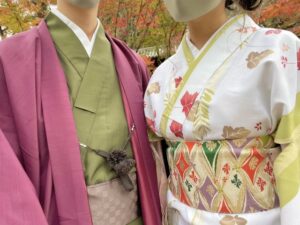
大名行列は、日本各地を走る「五街道」沿いの地域で、昔の一大行事を再現し、継承するために全国各地で開催されています。
大規模なイベントでは総勢100人にものぼる人々が出演しますが、それぞれの役割には歴史的な意味があり、伝統的な演技が受け継がれています。
出演者は一般公募されており、市町村によっては、外国人の皆さんに生きた歴史を体験してもらうため、大名行列に積極的に招待してくれるところもあります。
出演者にチャレンジするもよし、仲間といっしょにパレードするもよし、ぜひ地元の大名行列を楽しんでください。
Daimyo processions are held by communities in different parts of Japan to recreate and inherit the great events of the past, which follow along the “Five Roads” that run throughout the country.
In large-scale events, as many as 100 people perform in the procession, and each role has its own historical significance inheriting its own traditional performances.
Performers are open to the public, and some municipalities actively invite foreign residents to participate in the Daimyo performances so that they can experience living through history.
Whether you are interested in becoming a performer or parading with your friends, we hope you will enjoy a local Daimyo procession.

